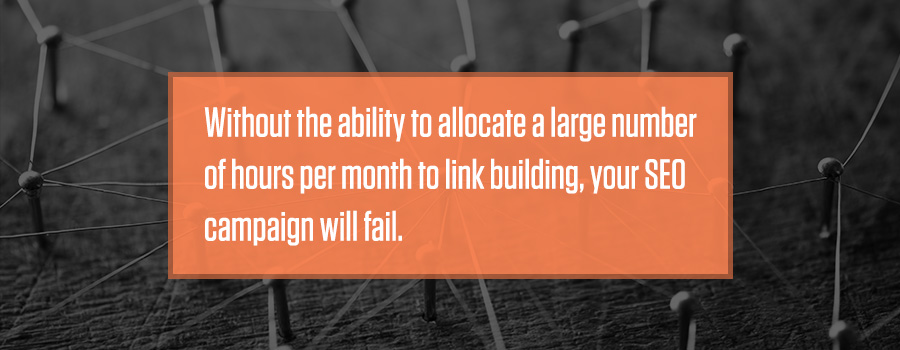
The Nitty Gritty Of SEO Execution
Why Your SEO Campaign Is Failing, and How to Fix It
Time and time again, we see companies come to us with failed SEO campaigns. Some have hired SEO agencies, and others have tried to do the work in-house. The majority of these companies have been adding new content to their website, writing blog posts and posting updates to their social media sites. Some are focused on fixing on-site issues such as redirects, H1 tags, image alt text and duplicate content issues, while others are only worried about link building. They wonder why they are not seeing organic traffic increases and more sales leads or e-commerce revenue.
The reality is that they have hired an SEO agency or in-house staff that doesn’t understand how to create and execute a basic SEO production plan. Instead, they work haphazardly, making big changes and minor tweaks that lack impact because they are not orchestrated.
If you work as an SEO resource on the agency side or in-house, it is important that you understand the basics of an SEO production plan. The same holds true if you are a business owner or someone who is responsible for hiring and managing an SEO agency or in-house resources.
To begin, let’s assume we are dealing with a small business that has five services and has never done any SEO work. At a minimum, the website has a home page and a page for each service. Each of these pages has 500 to 1,000 words of content. To make things a little more interesting, let’s also assume that the business hasn’t added any new content to its website since it launched a few years ago, it doesn’t have a blog, and it hasn’t set up any social media sites.
SEO Technical Execution Explained, Without Jargon

1. Link Building Resources
Quality link building continues to drive around 90 percent of SEO results. The first thing you need to focus on: How many hours can I afford to invest in link building each month? Without the ability to allocate a large number of hours per month to link building, your SEO campaign will fail. We commonly see that building quality links can take around eight hours per published link. With an average of 22 working days per month, one skilled, full-time link building resource could build about 22 quality links per month.
2. Keyword Research
For our example business with five services, you will want to conduct your keyword research in six batches. The first batch should focus on home page keywords that describe the type of business at the highest level, while the five remaining batches should be focused on keywords for each service page of your website. Depending on the business, doing keyword research for six topics should take 9 to 12 hours. Google Keyword Planner, Moz, SEMrush and Google Search Console are all good tools to help you build big keyword lists for each topic. A keyword combiner tool also can help speed the process.
3. Keyword Strategy
Having completed keyword research, you now need a way to filter down your keyword list to allow you to choose your target keywords and map them to pages on your website. Without this step, you will be left with an unfocused SEO campaign that will struggle to produce results. Every business is unique, so this process may vary a bit, but here is a simple one that we have used with success:
- Create a spreadsheet with a worksheet called All and two columns: Keyword and Volume. For the first batch/topic of keywords, add them to this worksheet and pull the average Google monthly search volume from the Google Keyword Planner. Sort your keywords from highest to lowest search volume. Keep either the singular or plural version of each keyword; not both. Delete any keywords with zero search volume.
- Add a second worksheet called Volume & Intent. From your first worksheet, copy over keywords (and volume data) that have a search volume of 50 or greater. Note that you may want to adjust that number up or down depending on your business and the keyword set you are working with. The goal should be to retain fewer than 100 keywords for this list. Add another column called Intent. Here you will want to manually review and mark each keyword and confirm that the searcher’s intent for using this keyword would be to find a business like yours. General and informational keywords will not have searcher intent. If you are unsure of the intent of the searcher, do a quick Google search for the keyword and see if the majority of first-page results are competitors.
- Add a third worksheet called Targets. Copy over all keywords from the Volume & Intent sheet that have the Intent column checked. You should be left with a keyword list of fewer than 50 keywords. Sort these keywords by highest to lowest search volume. To give you more insights into these keywords, you can add the difficulty, opportunity and potential metrics from Moz’s Keyword Explorer tool to each keyword.
- Another thing you can do at this step in the process is take a couple of your target keywords with the highest search volume, and run them in Moz’s Keyword Explorer to find the competitor sites that rank in the first three spots in Google. Take those domains and run them through the Majestic tool and look at the number of referring domains. This will give you a general idea of how many links your competitors have and how many links you need to build to eventually move up into those ranks. At the general number of eight hours per quality link, you will be able to do the math and understand how many resource hours will need to be invested in link building. You can take that number and compare it against your monthly budget to understand how many months it will take you to reach that number of links. If this is a shocking number, you may want to modify your target keyword selection to go after keywords with less search volume, which commonly have competitors with smaller backlink profiles.
- Each batch of keyword research/strategy should target one page of your website. Repeat this process for each batch of keyword research.
4. Keyword Implementation
Now that you have a list of target keywords for each page of your website, you need to align your on-site content and off-site link building with these keywords. Here is a general guide for implementing keywords into your target web page:
- Title Tag
- Write a new title tag.
- Limit length to fewer than 60 characters.
- Test with Moz’s title tag preview tool.
- Include your top keyword target once, at the start of your tag.
- Work in additional keywords or individual words (as the above limits allow).
- Do not duplicate any individual words.
- Meta Description Tag
- Write a new meta description tag.
- Limit length to 155 or fewer characters.
- Include your top keyword target one time.
- Write in sentence format and include a CTA.
- Headline Text
- Write a new headline to include your top keyword target.
- Body Text
- Edit existing page content to include your top keyword target and additional keyword targets up to two times per keyword.
You now need to have an anchor text plan for your link building. Here is a general guide to follow for a site that has little to no link profile established:
- 33 percent brand
- 33 percent brand + keyword
- 33 percent keyword
Varying anchor text is critical. When you are inserting the brand name, be sure to use variations such as Company Name; Company Name, Inc.; domain.com; http://www.domain.com, etc. When you are inserting the keyword into the above formula, make sure to cycle through your entire target keyword list. Do not use the same keyword every time.
5. Content Asset Creation
In order to build quality links today, you need to be creating quality content assets that you are publishing on your website. These content assets must provide valuable information to a reader. They can be in the form of infographics, guides, contests, presentations, white papers, quizzes, free tools, etc. When you publish these content assets to your website, you will want to include an embed code to make it easy for other websites to publish your content asset with a link back to your target pages, using your anchor text.
6. Link Building Production
As noted in Step 1, quality link building continues to be responsible for around 90 percent of SEO results. You need to have at least one skilled link building resource working on your SEO campaign. Link builders need to be experts in researching publisher websites, crafting personal outreach/pitch emails, tracking their outreach, following up with publishers, tracking links, etc. The single most important element of link building is securing backlinks from high-quality domains with a variation of anchor text back to your target pages that you want to rank in Google.
By creating and executing a basic SEO production plan, you will see success with your SEO campaign. While blog posts, fresh website content and social media activity are nice things to have, you will see that you really don’t need any of these activities to have a successful SEO campaign.
Further SEO Study
- For more information about content asset creation and building quality links from these content assets, check out our Content Link Building Playbook.
- For an A-to-Z discussion of successful off-site SEO, read our Outreach For SEO white paper.
- For guidance on creating meaningful and persuasive business content, read our 150 Business Jargon Fixes article.




